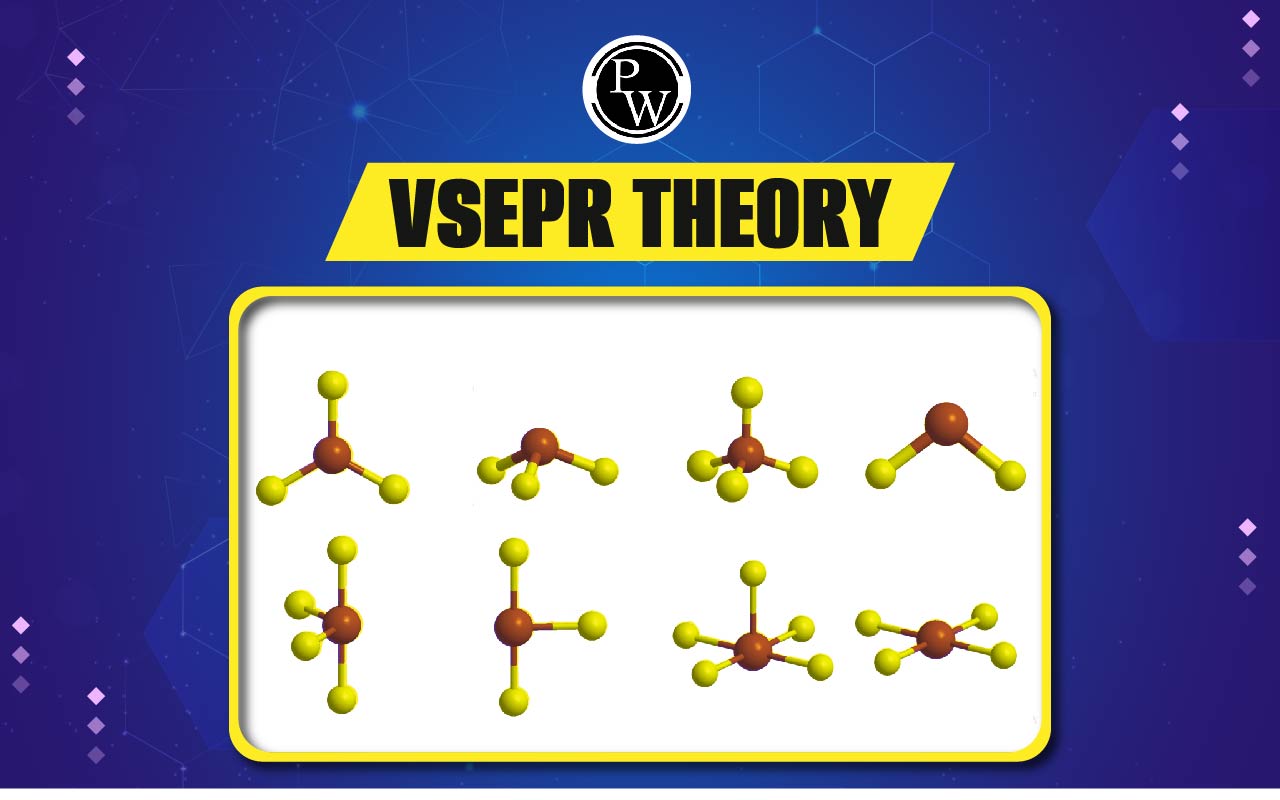

VSEPR Theory (Valence Shell Electron Pair Repulsion) : The first simple theory that was put forward to explain the shapes of molecules is known as the Valence Shell electron Pair Repulsion (VSEPR) theory. This theory was given by Sidgwick and Powell in 1940 and was further improved by Nyholm and Gillespie in 1957.
The VSEPR (Valence Shell Electron Pair Repulsion) theory is a fundamental concept in the field of chemistry, providing a predictive model for the three-dimensional shapes of molecules based on the repulsion between electron pairs in the valence shell. The VSEPR theory has become an indispensable tool for chemists to predict molecular geometries, which in turn influences various aspects of chemical behavior. However, like any scientific theory, VSEPR has its limitations, and its applications extend beyond predicting molecular shapes.
VSEPR Theory
Important Points To Remember :
Note :
If the central atom possess only bonded pairs of electrons along with identical atoms then shape of the compound is symmetrical and according to Sidgwick & Powell.
Eg:
-
BF
3
–
– Triangular
CH
4
–
– Tetrahedral
CO
2
–
– Linear
If the central atom possess bonded pair of electrons as well as lone pair of electron, then shape of the molecule will be unsymmetrical i.e,. the original bond angle will disturbed due to repulsion between lone pair of electrons.
By increasing one lone pair of electrons, bond angle is decreased approx by 2.5°.
Eg: - CH 4 NH 3 H 2 O → sp 3
109 o 107 o 105 o Hybridization
Types of Hybridization And Possible Structure
|
General Formula |
Electron pairs |
Bonding pairs |
Lone pairs |
Arrangement |
Shape & Geometry |
Bond Angle |
Examples |
|
AB 2 |
2 |
2 |
0 |
|
Linear |
|
CO 2 , BeCl 2 |
|
AB 3 |
3 |
3 |
0 |
|
Trigonal planar |
|
BF 3 , SO 3 |
|
AB 2 L |
3 |
2 |
1 |
|
Bent/V Shaped & Trigonal Planar Geometry |
|
SO 2 , SnCl 2 |
|
AB 4 |
4 |
3 |
1 |
|
Pyramidal Shape & Tetrahedral Geometry |
|
CH
4
,
|
|
AB 3 L |
4 |
3 |
1 |
|
Pyramidal shape & Tetrahedral Geometry |
|
NH 3 , XeO 3 , PCl 3 |
|
AB 2 L 2 |
4 |
2 |
2 |
|
Bent or V-Shaped & Tetrahedral Geometry |
|
H 2 O, OF 2 |
|
AB 5 |
5 |
5 |
0 |
|
Trigonal Bipyramidal Geometry |
|
PCl 5 , SOF 4 |
|
AB 4 L |
5 |
4 |
1 |
|
Square planar |
|
SF 4 , XeO 2 F 2 |
|
AB 3 L 2 |
5 |
3 |
2 |
|
T-shaped & Trigonal Bipyramidal Geometry |
|
ClF 3 |
|
AB 2 L 3 |
5 |
2 |
3 |
|
Linear shape & Trigonal Bipyramidal Geometry |
|
XeF
2
,
|
|
AB 6 |
6 |
6 |
0 |
|
Octahedral Geometry |
|
SF 6 |
|
AB 5 L |
6 |
5 |
1 |
|
Square pyramidal shape & Octahedral Geometry |
|
BrF 5 , XeOF 4 |
|
AB 4 L 2 |
6 |
4 |
2 |
|
Square planar shape & Octahedral Geometry |
|
XeF 4 |
|
AB 7 |
7 |
7 |
0 |
|
Pentagonal Bipyramidal Geometry |
|
IF 7 |
Limitations of VSEPR Theory
1. VSEPR Theory fails to explain isoelectronic species.
2. According to VSEPR theory, a shape of the molecule depends on the number of bond pair and a lone pair (valence electrons). But isoelectronic species can differ in the shape even if they have a same number of electrons.
3. VSEPR Theory does not explain the transition metal compounds.
4. VSEPR model fails to guess the structure of certain compounds. The reason being that it does not take associated sizes of the substituent's and inactive lone pairs into account.
Applications of VSEPR Theory
- To predict the three-dimensional shapes of molecules.
- VSEPR theory enables us to Predict the approximate bond angles of a molecule, by the examination of bonds & lone pair of electrons.
VSEPR theory FAQs
Q.1. What is VSEPR theory, and how does it help in understanding molecular shapes?
Q.2. How does VSEPR theory categorize electron pairs, and why is this classification important?
Q.3. Can VSEPR theory be applied to all types of chemical bonds?












